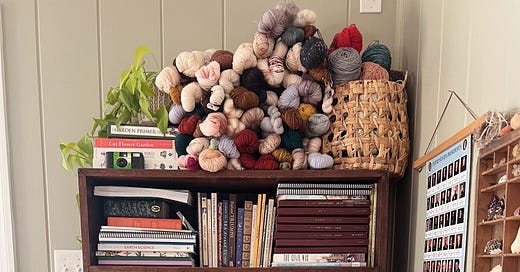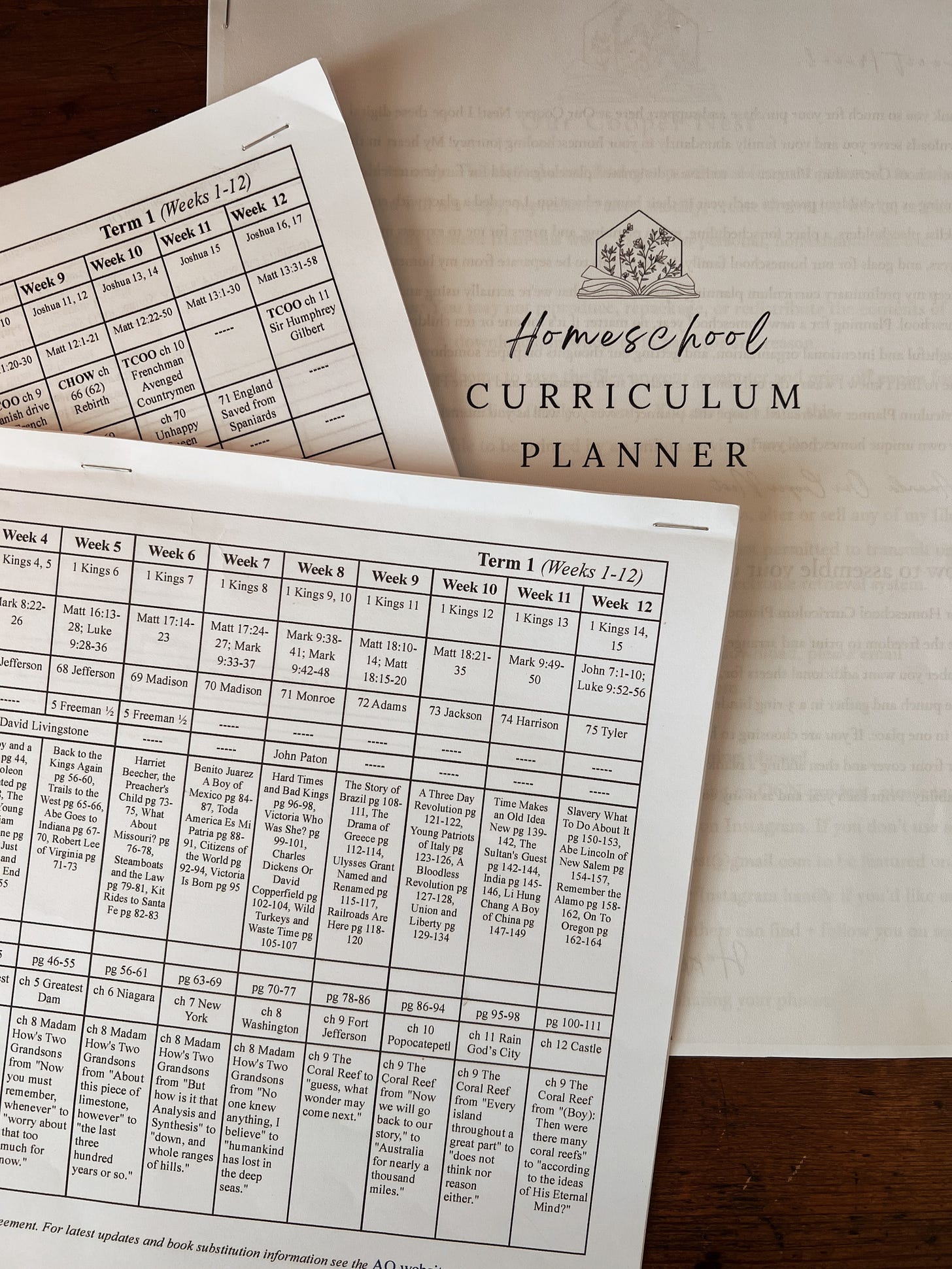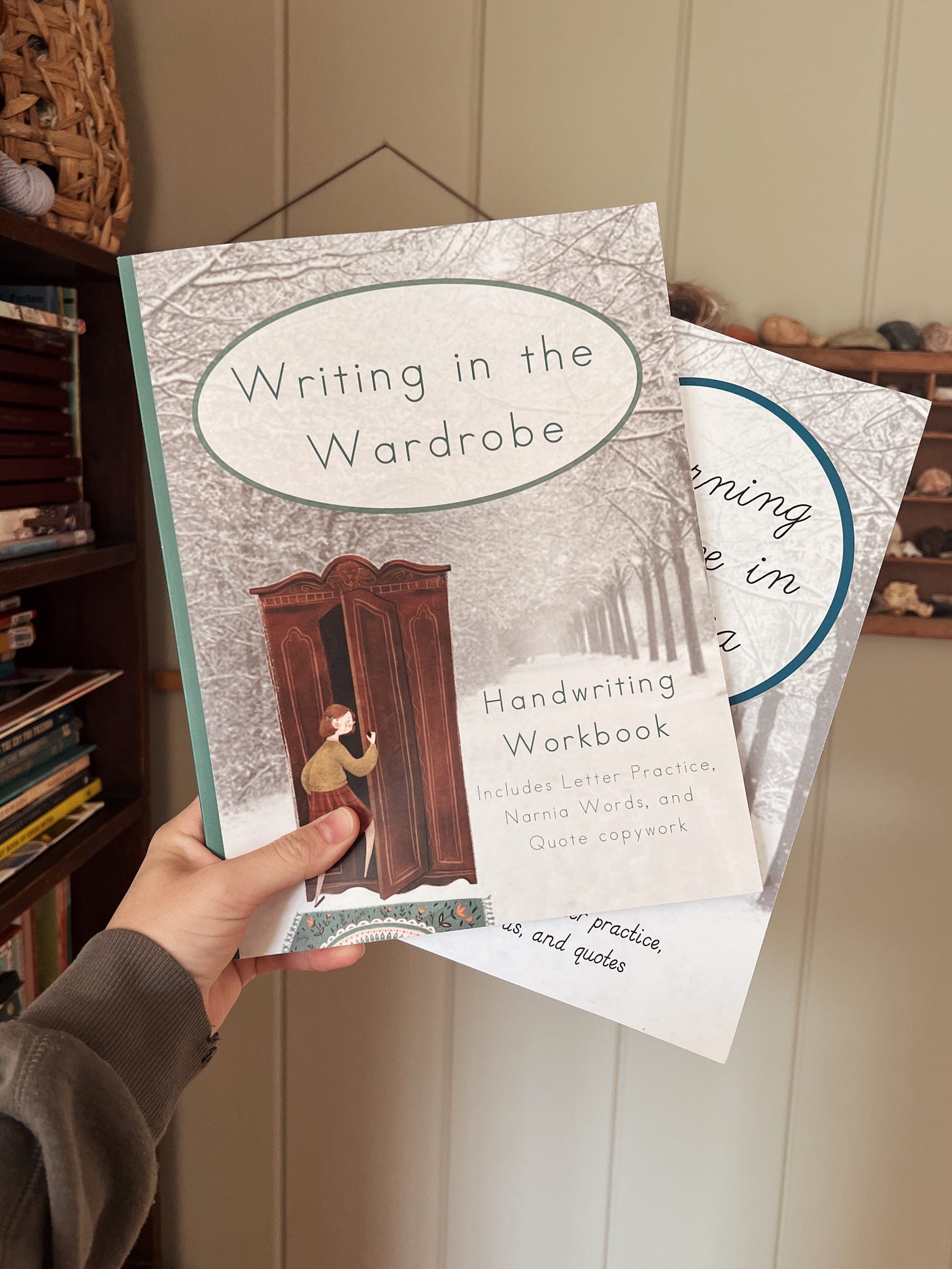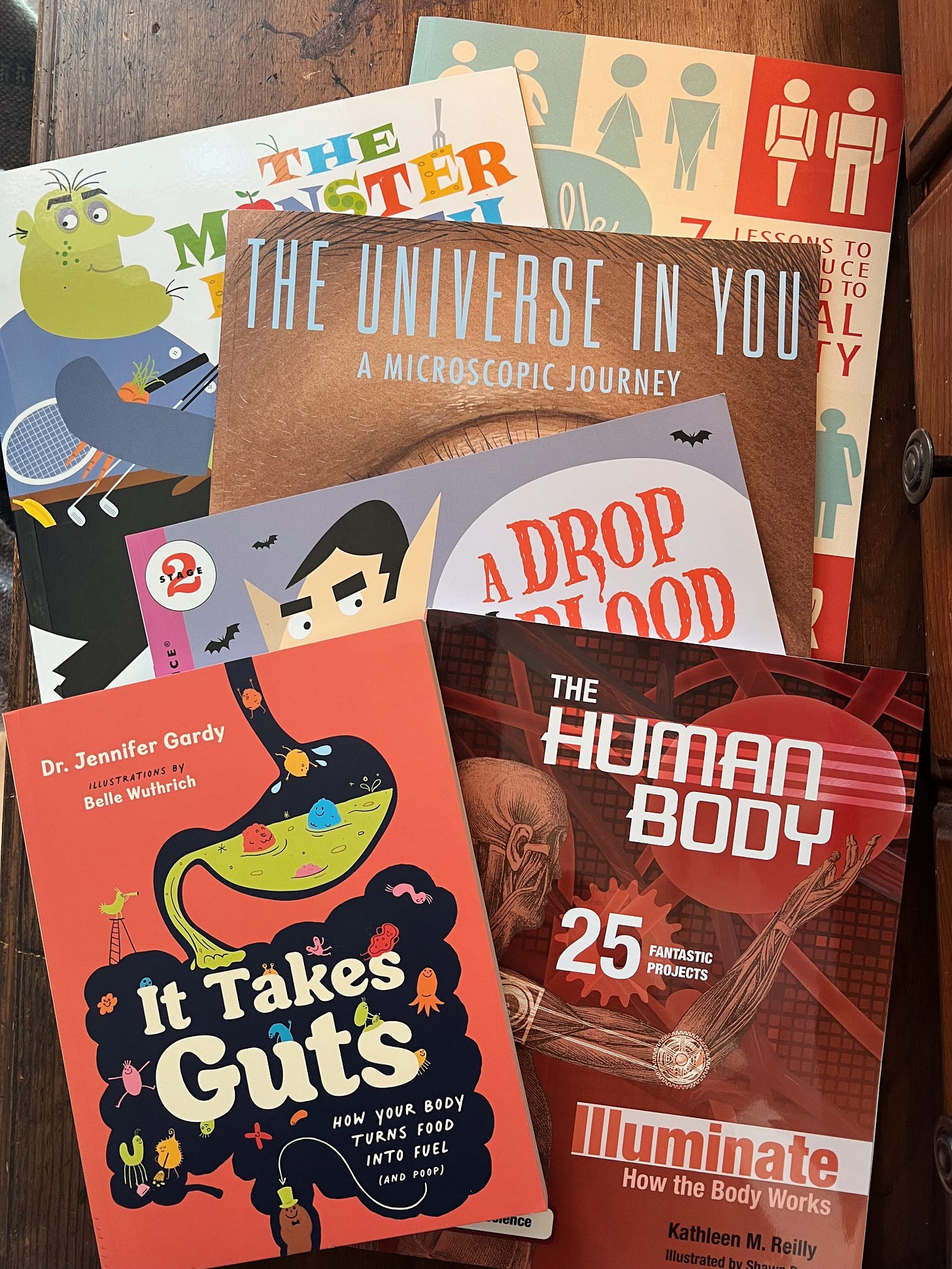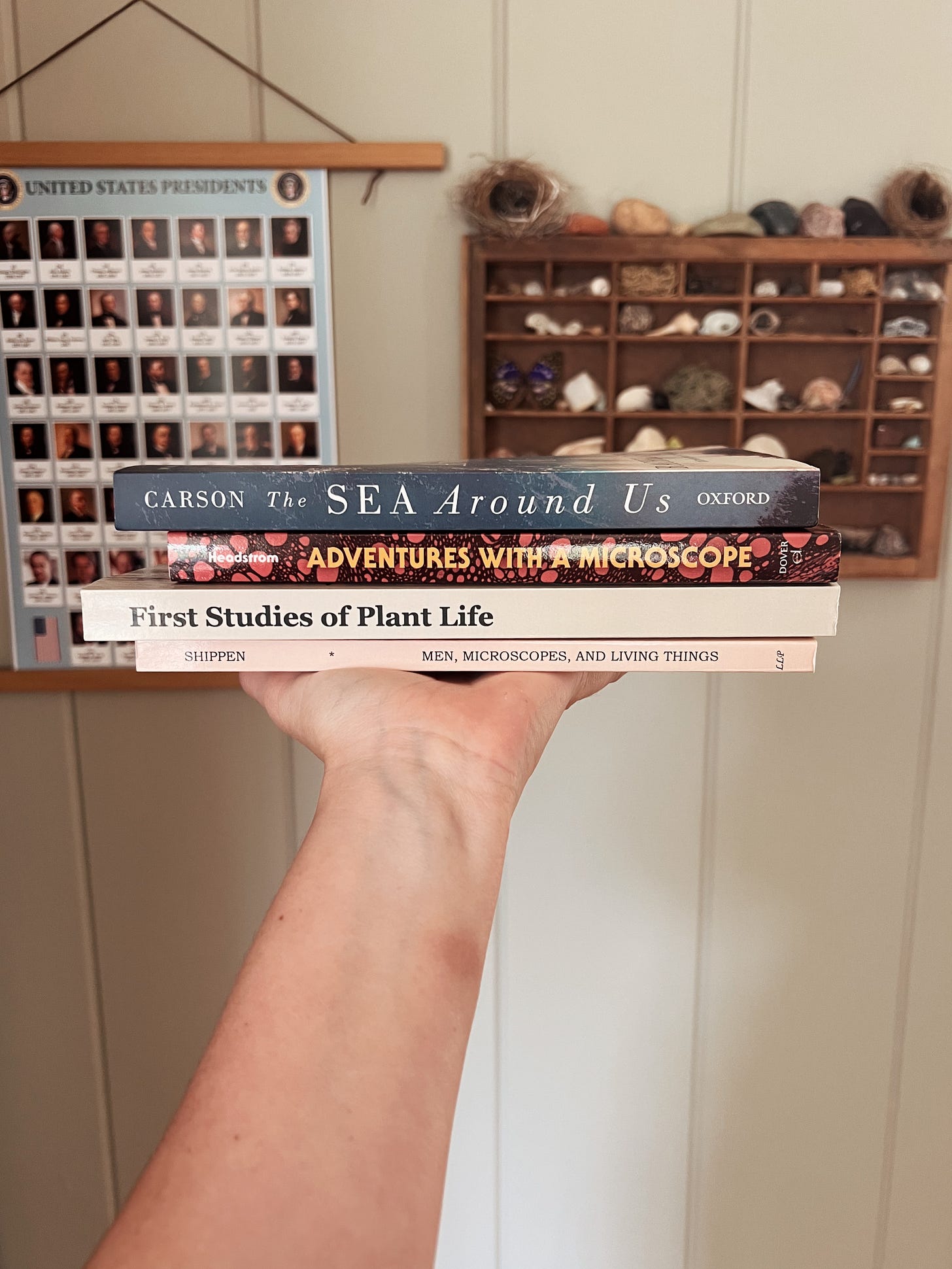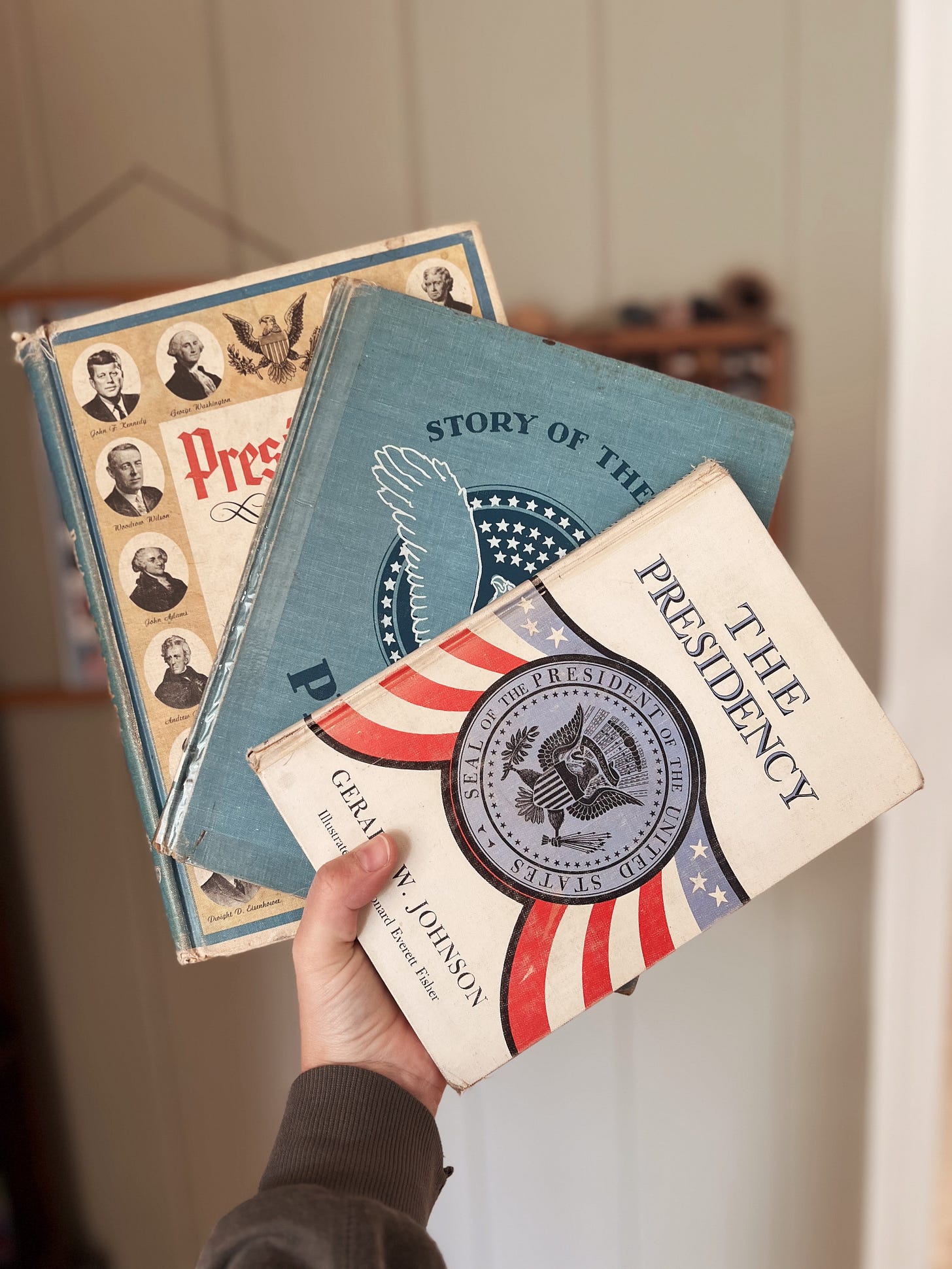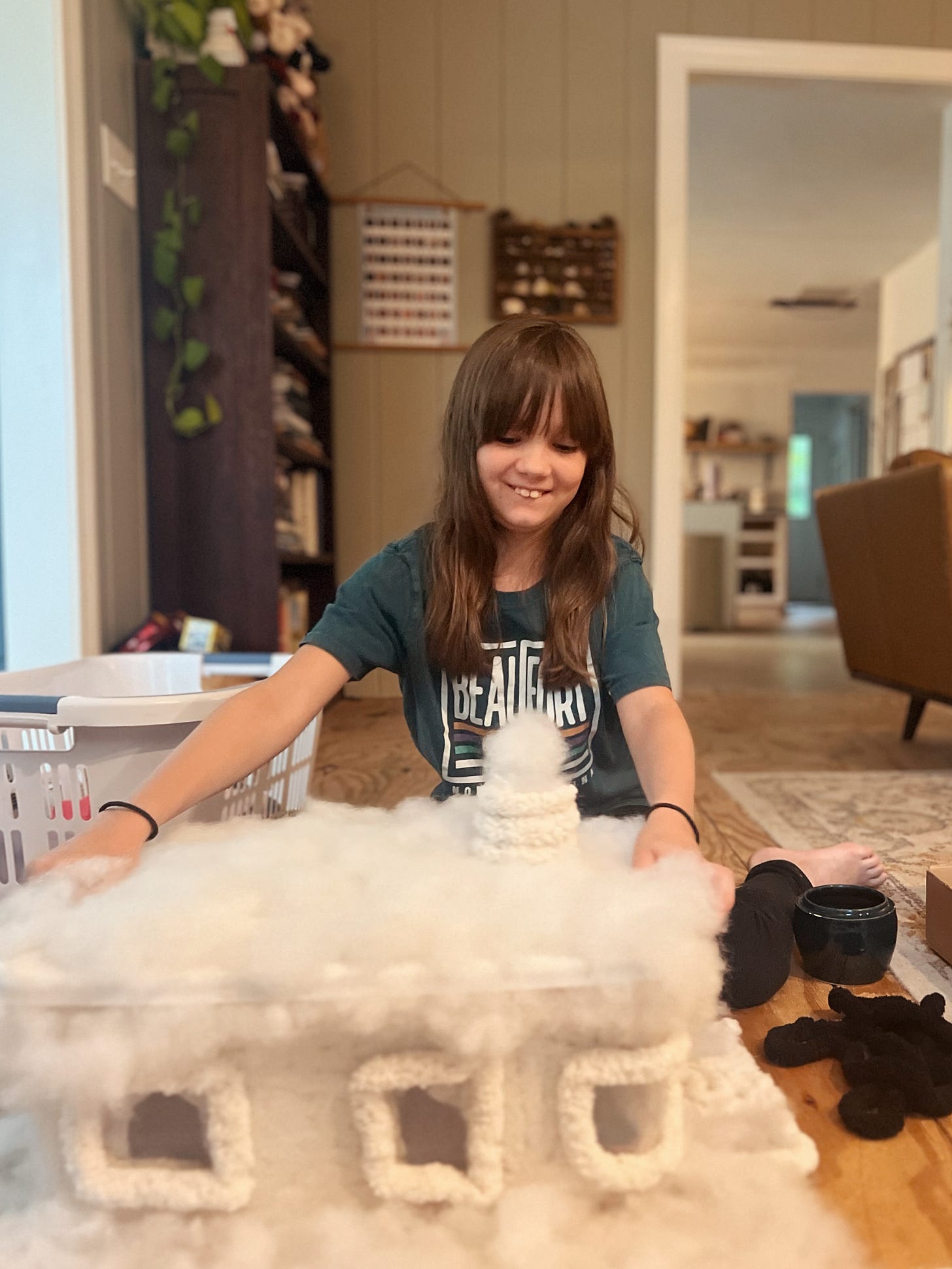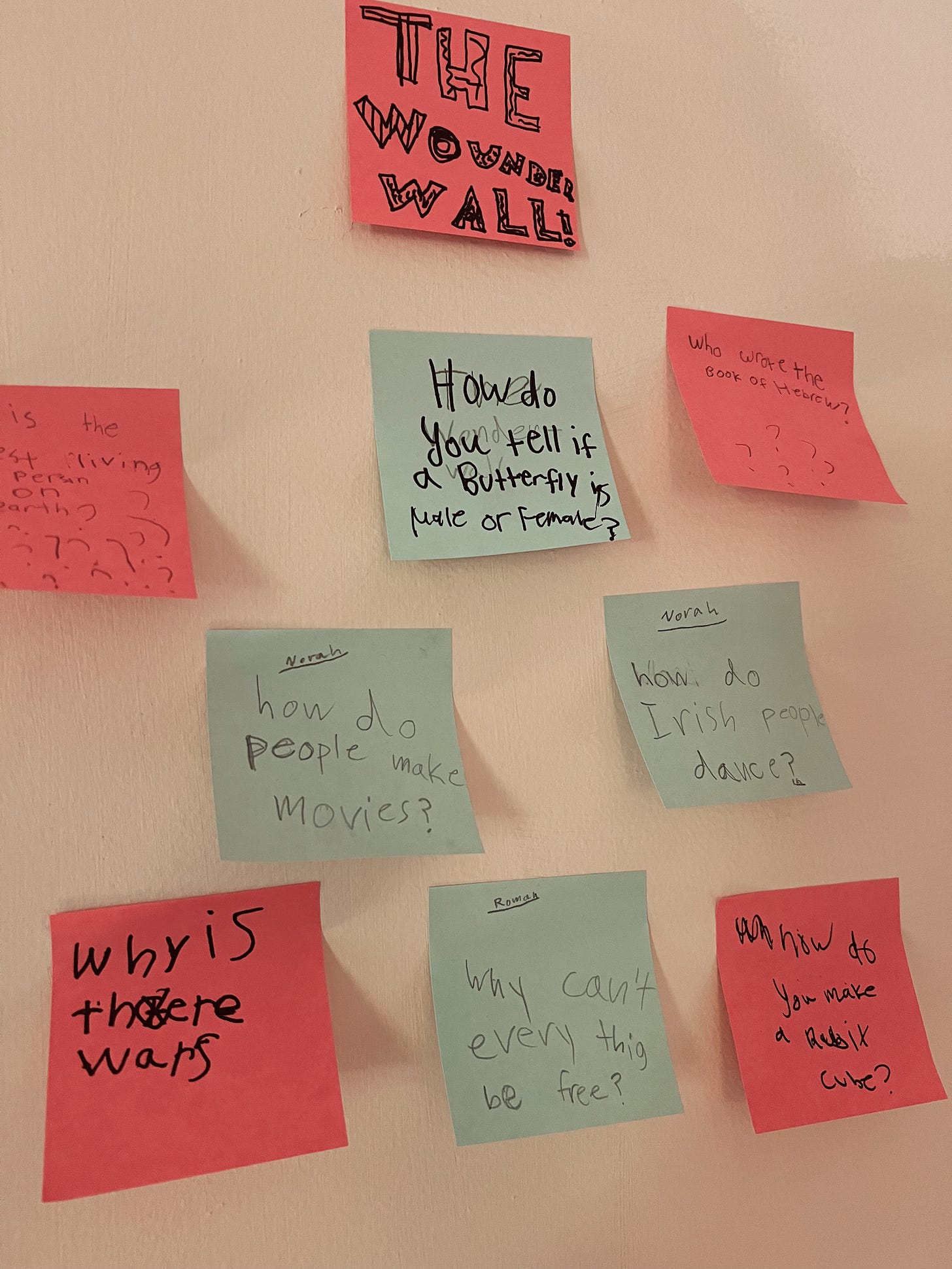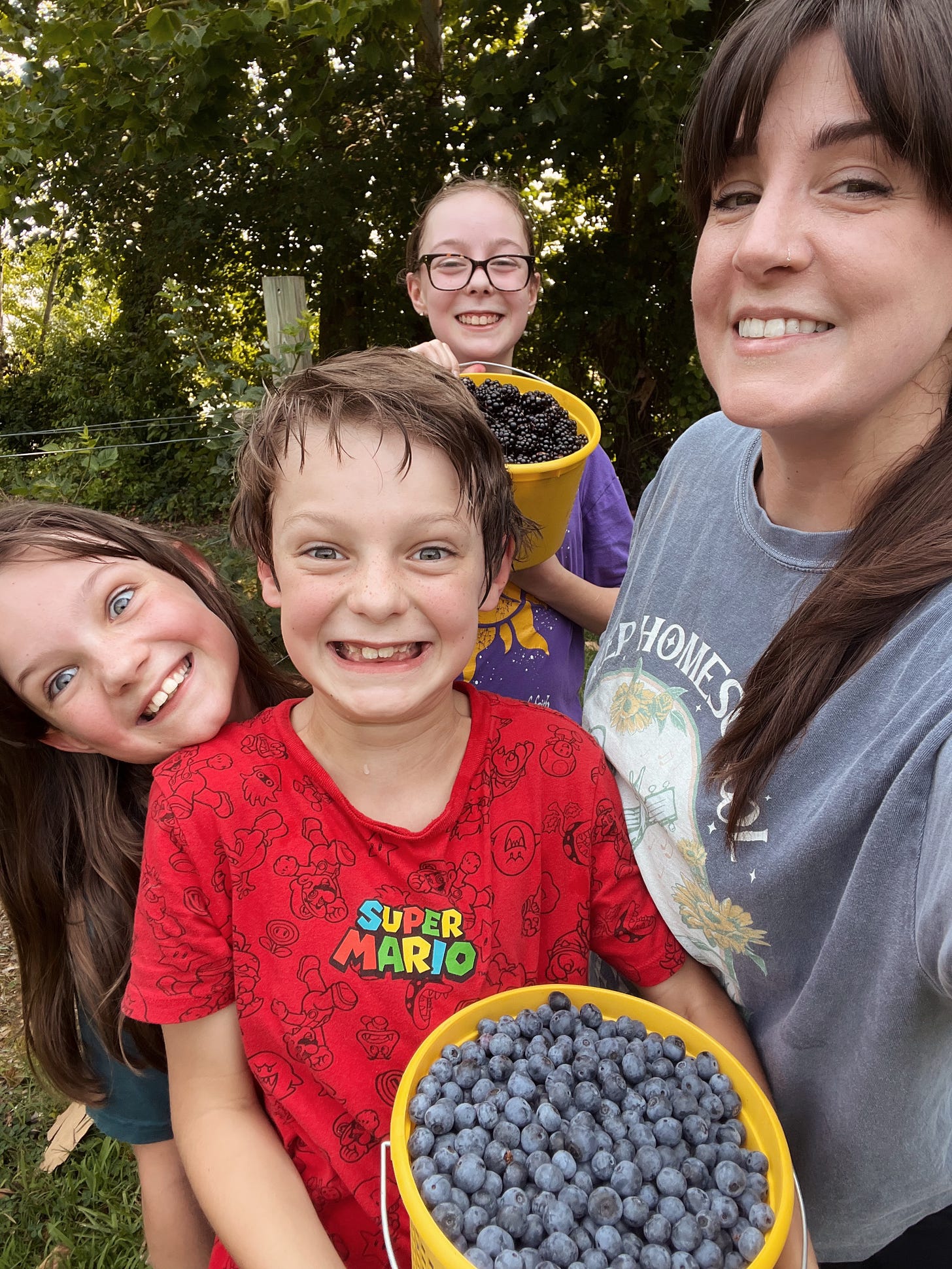“Without vision the people run wild, but one who follows divine instruction will be happy.” Proverbs 29:18
“Why - why,” said Elizabeth Ann, “I don’t know what I am at all. If I’m second grade arithmetic and seventh grade reading and third grade spelling, what grade am I?”
The teacher laughed at the turn of her phrase. “You aren’t any grade at all, no matter where you are in school. You’re just yourself, aren’t you? What difference does it make what grade you’re in!”
Understood Betsy
This is going to be a longer than average newsletter, but I put in lots of pictures and a gif to keep you entertained. I have big feelings about homeschooling and books, so I’m naturally long winded about both, but it’s also impossible to break down an entire years work for 3 different children in an email. I wanted to give each subject it’s due diligence, and I’ve included as many links as I can.
You’ve been warned.
Choosing what curriculum to use is almost as daunting as deciding to homeschool in and of itself. I have a few trusted people I listen to when planning for the new school year, and I enjoy seeing not just what is being chosen, but why. I’ve spent the last few weeks really ironing out our choices for the next year, and I’d love to share them with you.
There are two main principles that guide me when I’m homeschooling, and I frequently have to remind myself of them. First, that my children are not my own, they are gifts from the Lord, and my job is to hear His vision for their educations and point them to the truth. The second is that they are people, uniquely gifted, and no set program will ever be a perfect fit for all three of them. Their strengths and weaknesses are things to inform my choices, not define our success. There is no behind in our homeschool. You are where you are, and where you are is good.
Taking a moment to reflect on the previous year is always a good place to start. What worked well? What did we despise doing? Which subjects made my kids eyes light up, which made them turn themselves inside out and melt through the floor and into the crawlspace and roll around with the worms in the dirt before coming up for air just to whine about the injustice of it all? If you think that’s an exaggeration, you’ve never homeschooled before. Either that or my children could win the world record for whining. We may never know.
I used these Homeschool Planner pages to help me work through some of those questions. I loved that she even included meal planning pages because educating the children is one thing but feeding them 3 square meals and 12 snacks a day is another. I’ll save a later post for meal planning and recipe sharing, because I think we’ve got a good system going, and sharing is caring.
We are going to use Ambleside Online (AO) again this year for our curriculum, with a few swaps and substitutions. My kids will be in 10th, 5th, and 3rd grade, and we will use year 5 for the older two and year 3 for my 3rd grader. My oldest has an alphabet soup of diagnoses, and year 5 fits her ability best. Year 5 is a stretch for my 5th grader, but not a big one, and my 3rd grader is right where I’d want him to be to start year 3. I’ve done AO since my oldest was in Year 0, and although I haven’t always used it for every subject, it’s very familiar to me. I love this curriculum, but I loathe the purist mindset that demands strict adherence to the outlined books. Charlotte Mason didn’t give us a booklist, she gave us a method, and she gave us freedom in that method to do what works for us and our children. There isn’t a single booklist or curriculum that will work for every child. What I share here is what works or what I think will work for my children, in this season, operating within my strengths and weaknesses. I’ve never liked being told what to do, so you won’t hear me telling you what to do either. I hope you read freedom and choice in this newsletter, and nothing else.
Morning Basket
This concept feels as old as homeschooling itself, but if you haven’t heard of it, it’s simply a stack of things you do all together, in the mornings before you start school. Some people call it morning time, but we actually call it the lunch basket. For a few months I really beat myself up for not being able to get this particular thing done before noon, and we developed a habit of finally pulling it out when we all sat down to eat lunch. Instead of forcing something that didn’t feel natural to our rhythm, we just went with it. It usually takes us 30-45 minutes to complete, depending on the day, and it’s where I scheduled the things we do all together. This first half of this list we do every day, the second half we chose one thing per day.
Bible - AO schedules Bible reading for each year, but we’ve never followed it. When someone is new to reading scripture, you don’t hand them a Bible and start them in 1 Kings or Exodus, so I’m choosing more approachable places for the kids to read based on their reading level and understanding. I also don’t have the capacity to teach three different passages to each of them. I’ll be assigning individual passages for each child (which I haven’t decided on yet) to encourage them to take their spiritual growth personally, but we will continue reading through the Bible as a family during our Lunch Basket. We’re currently using Exploring the Bible and enjoying it. It does skip some passages that I wish it covered, so we chose to read through those, but I enjoy that this gives them a broad picture of scripture from beginning to end, and that we can dive deeper into smaller sections together when time allows.
Folk Songs & Hymns - Such a fun part of lunch basket! I have one reluctant singer, but we don't force it, and we’re praying the Lord develops in them a heart to worship through song. We found folksandhymns on YouTube last year and haven’t looked back. She sends out the lyrics and the mp3 on her patreon every month, and financially supporting her in this has been a joy.
Read Aloud - Last year we read the Wonderbook by Nathaniel Hawthorne, and Peter Pan. We’re still working through Peter Pan, but after we’ve finished, I’m going to read D’aulaire’s Greek Myths in it’s place, then pick a free read from past AO years we haven’t gotten to, going back and forth between myths and fairytales.
Foreign Language - We are all loving Madame Lee’s French Feast. It’s very gentle, and feels much more natural to us to follow along with her videos than to learn from a book. We’ve tried talkbox.mom, Duolingo, and Getting Started with French, and this one the kids ask to do, which is such a win.
Current Events - We have gone back and forth on a World Watch subscription, but haven’t found another way to give them age appropriate current events. Some of the stories go over their heads, and others feel too heavy to burden them with, but ultimately it does provide good conversation around topics I wouldn’t otherwise think to share with them.
These are the weekly subjects we do during lunch basket:
Composer Study - Following along with Ambleside’s schedule, we will be covering Frederick Delius, Mozart, and Mendelssohn. I like to create our own playlist on Spotify for the pieces we cover and we will listen to one song for 2 weeks, until we’re comfortable with it, and then move on to the next, in order to cover 6 pieces in a term. I’ve also been purchasing a record of the composers as we study them, to help us slowly build a collection of classical music.
Artist Study - All the beautiful things for lunch! One artist per term, 6 of their works total, means 2 weeks of enjoying one nice and slowly. Pissarro, Fragonard, and Bierstadt are going to be household names this next year and I cannot wait. I love purchasing the Picture Aids and Study Guides from A Humble Place. I use a small easel to prop up each work of art where we can see it regularly, only pulling it out once a week to do some sort of activity with it. Sometimes we play I Spy with the more complicated pieces, sometimes we sketch it out on the chalk wall, or try to recreate it with things around the house. We pull out a tape measure and see how big it actually is, and look up where it is being displayed. Once a term, I trace the outline of whichever is the unanimous favorite onto watercolor paper and the kids get to paint their own version.
Shakespeare - We’re reading through Charles & Mary Lamb’s retellings, at least for one more year before reading the actual plays. I purchased The Tempest last year so they could see how the play is written and what the structure is like, and both girls have independently started reading it, but it will be another year before we’re solely reading the plays. I pulled How to Teach Your Children Shakespeare off my shelves to work through on my own this year. I’ve never finished it, and I’m looking forward to seeing what he has to say.
Plutarch - I spent days agonizing over translations last year, and ended up spending too much money buying both North’s and Dryden’s. I purchased study guides and bought PDFs to help us stay organized and on track and we read exactly half of Alcibiades. I’m determined to get through at least one full life this year, but I’m holding it loosely.
Math
All three children will continue with The Good and The Beautiful (TGATB), but I will be adding Life of Fred in a few times a week for Roman.
I love the spiral mastery of TGATB, and that it is slightly more advanced than other programs I’ve found. My kids love how visually engaging the curriculum is and the videos that go along with the upper level lessons. The only downside is that the lessons take a while, usually due to the sheer amount of problems in each lesson. We typically cross off half the questions in each section, only completing all the problems if it’s a concept my kids are struggling with.
Roman’s hand fatigues quickly after writing, and he was getting exasperated with TGATB not because the math was hard, but because his hand was too tired to keep writing the answers. We used The Life of Fred for him for 2024-2025 school year, and it was been a wonderful way to keep him engaging with math concepts while strengthening his stamina with handwriting. The story is very engaging, and we’re happy to keep working through these books along side TGATB next year.
Language Arts
We have exclusively done TGATB language arts program, but I’m seeing more resistance and the lessons are taking up a significant amount of time. Roman has about 20 lessons left in level 2, and after he completes them I will likely order him level 3, because it is unsurpassed, in my opinion, in teaching early reading skills. However, nothing has killed my children desire to write creatively like the writing prompts, and spelling is an afterthought in this curriculum. TGATB is wonderful if you don’t already have geography, art, or poetry plans, but it’s cumbersome if you do. They don’t enjoy the assigned reading, and it feels unnecessary to enforce it when we are reading so many other wonderful books during the year. For the girls, we are switching to Spelling Wisdom and Fix It! Grammar, and I’ll be requiring more written narrations from them both this year to strengthen their writing skills. I did have to purchase Spelling Wisdom from another site, because the are sold out on the one I’ve linked, but I wanted to send you to the manufacturer.
Both girls will continue to practice cursive this year, but we’re going to use this book instead of TGATB. Roman will be using a similar book, with a focus on printing. I love that these are more like traditional copywork than simply repetition.
Science
Roman will do year 3 science as it is written. A few days ago he asked me a question to which the answer was buoyancy and surface tension, so I think Drops of Water will be perfect for him. Pagoo is a great introduction to marine life, and we will support those chapters with videos on the ecosystem and animals Pagoo encounters.
Norah will do Great Inventions as written in the year 5 curriculum, but we are substituting all others. She’s too sensitive for Wild Animals I Have Known, but she did request to learn more about animals, specifically their skeletal structure (keep homeschooling weird, guys), so I ordered a few books for her off the Sabbath Mood Nature Lore list to replace that one. I also have All Creatures Great and Small, which may work as an audio for her. We did not do Madam How or Lady Why this year, and will be skipping it again next year. The anatomy book AO has scheduled has some pretty scathing reviews, so I’ve opted to follow the Ambling Together anatomy schedule instead.
Ali will be doing Great Inventions as scheduled, but also skipping all others. I’ve ordered two Sabbath Mood guides for her for the next year - Biology and Botany, which she will do in place of anatomy. We’ll revisit anatomy next year using the Sabbath Mood guide. We’ll also use Adventures with a Microscope in place of Madam How and Lady Why, and read/listen to The Sea Around Us instead of Wild Animals I Have Known, to follow her interest in marine life.
Geography
We will be following Ambleside’s geography plans for year 3 for Roman and year 5 for Norah and Ali, using Long’s Geography, Elementary Geography, and Halliburton’s Marvels. Ali tried Halliburton last year and it quickly overwhelmed her. She needs a lot of scaffolding before geography, so we will focus really heavily on map work, reading this one together, and using this guide to play videos to go along with each location. I’m hopeful that doing it with Norah will provide the camaraderie she needs to handle a subject that feels too abstract for her.
We’ll continue to use the Seterra app for weekly map drills.
History
Roman will be learning about the 1400-1600s this year, covering everything from the Renaissance to the Pilgrims. We’re going to read about Leonardo da Vinci and Marco Polo, and continue reading through Our Island Story to learn about the English monarchs during that period. The only book we’ll be dropping is Trial and Triumph, which we will read together at a later time.
Norah and Ali will be studying the 1800s-1914, as Ambleside has written. We chose to do a Marie Curie biography over Alexander Graham Bell, and we’re using the Signature Book about Theodore Roosevelt because we already own it instead of the one they recommend. I’ll also have Ali read a Florence Nightingale biography, since she fits into our time period and Ali’s interests.
We will touch on some North Carolina history this year as well, and read a book about the Presidency to round out what we’re reading in This County of Ours. The book is out of print, but lovely, so we will try to fit it in.
Literature
Roman and I will be reading Robin Hood, which we missed during year 2, The Jungle Book, and Children of New Forest. He remembers listening to Princess and the Goblin last year when I read it with Norah, so I’m not bothered about skipping it for now. We will reread it or add it in as an audiobook in another year or two, since its such a wonderful story. Roman requested we reread Pilgrims Progress, but we’ll be using this version. We’re dropping parables of nature, because we don’t enjoy it, but we will are excited to read American Tall Tales and The Heroes.
Norah will be reading King Arthur and His Knights of the Round Table by Roger Lancelyn Green. We have the version by Howard Pyle, but I think Green’s is more approachable and more on target for Norah’s reading level. She be reading Anne of Green Gables in place of Oliver Twist, because she is my most sensitive child. I do have a picture book that introduces Charles Dickens that I plan to read with her, and we will read A Christmas Carol over the holidays to get her familiar with one of his works. We didn’t get to Kidnapped this year, so we will read that one in place of Kim, because life is too short to read books you don’t want to, and I think Kidnapped will better encourage the love of literature that I want to cultivate. Down with the purists!
Ali’s already read King Arthur, so she will be reading Little Women, but I will have her read along with an audio version of Oliver Twist. For Term 3 she will also be skipping Kim and reading Kidnapped with Norah and I.
Poetry
Each child will read through the Ambleside selection for their year. Ali and Norah will be reading year 5, which focuses on Kipling, Longfellow, Whittier, and Dunbar. and Roman will be reading year 3, which is Sara Teasdale, Hilda Conkling, and William Blake.
Nature Study
We will follow Ambleside rotation for nature study which is reptiles for Term 1, brooks, rivers, ocean for Term 2, and garden flowers and weeds for Term 3.
We enjoy using the guides from Ambling Together to give some structure to our nature study, but more often than not I get books from the library pertaining to their topics, and take them places for their nature study where they have an increased chance to observe those subjects.
Handicraft
We choose three skills to learn together a year. Whether we actually learn these skills is an entirely different story. Handicrafts idea are baking, cooking, leather working, blacksmithing, pottery, basketweaving, gardening, keeping house, wood carving, knot tying, sewing, knitting, carpentry, embroidery, clay modeling, candle making, paper crafts, beadwork - it’s an endless list.
I need to refine some of their skills in the kitchen, so I’ll be assigning a night a week to each child, teaching them how to cook the chosen meal, and expecting them to shop (with me, obviously) for the items they need.
I think in the spring we will plant a victory garden, giving them some ownership over the hobby that I love so much.
Knot tying is an easy one to work on inside when its cold, and it has such a variety of uses. The girls can make bracelets and macrame, Roman can tie us all up and shoot us with nerf bullets, just an overall good time.
The kids have picked up counted cross stitch this summer, and have expressed an interest in learning to sew leather, so we may add/continue those as well.
I’m working on turning our school room into a craft space. I’m hopeful that having an area where we can create and learn new skills will enable us to do so, instead of them taking over the living room with their creations.
Drawing
We love Andrea Nelson’s art tutorials and Art for Kids Hub, both on YouTube. I imagine we will continue watching those for afternoon occupation.
For formal instruction, we’re going to use Bestowing the Brush’s beginner course.
Digital Literacy
We are not a tech savvy house, but I do want the kids to have some basic computer skills. We’ll be continuing lessons on typing.com, which is the simplest way we’ve found to each that skill.
A few years ago I heard about a concept called a Wonder Wall - taking all the questions the kids ask and putting them on a sticky note, in one spot of the house. I’m not sure what that mom did with those questions, but I plan to have them each choose one, and research it. I haven’t decided if I’ll ask them to write about it, because my goal with this is to teach them how to safely find good sources and navigate the internet.
I’m also going to have them create a monthly printable newsletter using Canva just for our own enjoyment, as a way to keep track of favorite field trips, stories, poems, etc and give them a place to showcase some written narrations or summaries on current events. My goal here is for them to just have fun with this, Little Women style. Put on costumes, come up with pseudonyms, play around with editing and collaboration. One big happy group project. What could go wrong.
I also have tentative plans to start a co-op, and a large stack of books to read myself to support what the kids are learning.
Ambitious?
Yes.
Worth it?
Always.
The affiliate life is still not for me, but I did provide links today because I know it makes things much easier. Please consider subscribing here if you’ve found the links helpful, because writing is more fun with friends.

